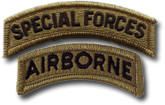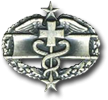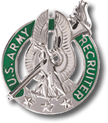Drill Instructor Badge
History
The Drill Sergeant Identification Badge is a military badge of the United States Army which was first issued on January 15, 1958. It is also nicknamed the "pumpkin" patch due to its appearance when worn in the non-subdued pin-on version and in the color sew-on version worn before insignia was subdued in the 1950s and 1960s. The badge is presented to any NCO who has completed the Drill Sergeant Course at any U.S. Army Drill Sergeant School, and has been assigned as a drill sergeant at a U.S. Army training command.
The drill sergeant identification badge is worn by all qualified drill sergeants. Each element of the badge has a specific meaning. It consists of 13 stars representing the original colonies. The torch, burning brightly, in the center symbolizes liberty. The snake is derived from the original ”Don’t Tread On Me” serpent on the Gadsden flag, a symbol of American independence during the 18th century. Together with the torch and breastplate, it indicated readiness to defend. The breastplate is a symbol of strength. The green background is a vestment worn under the breastplate. It's called a Jupon, which represents the new Army. The snake grasps, with his tail and teeth, a scroll inscribed “This We’ll Defend,” the motto of the United States Army. The inscription summarizes the meaning of all the symbols on the badge, depicting the determination, devotion, and constant readiness of the American soldier.
Prerequisites
Being assigned as a Drill Sergeant within S-4 after completing Drill Sergeant School.





































